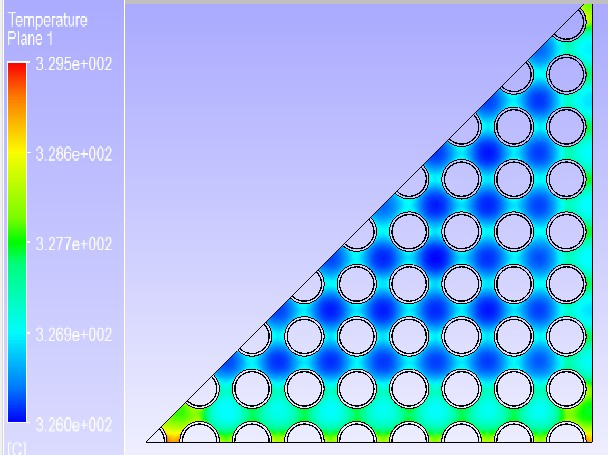Thermo-hydraulic Simulation of AP1000 Nuclear Reactor Fuel Assembly
DOI:
https://doi.org/10.14295/vetor.v31i1.13576Keywords:
Thermohydraulic, CFD Simulation, AP1000 Nuclear ReactorAbstract
One of the challenges of future nuclear power is the development of safer and more efficient nuclear reactor designs. The AP1000 reactor based on the PWR concept of generation III + has several advantages, which can be summarized as: a modular construction, which facilitates its manufacture in series reducing the total construction time, simplification of the different systems, reduction of the initial capital investment and improvement of safety through the implementation of passive emergency systems. Being a novel design it is important to study the thermohydraulic behavior of the core applying the most modern tools. To determine the thermohydraulic behavior of a typical AP1000 fuel assembly, a computational model based on CFD was developed. A coupled neutronic-thermohydraulic calculation was performed, allowing to obtain the axial power distribution in the typical fuel assembly. The geometric model built used the certified dimensions for this type of installation that appear in the corresponding manuals. The thermohydraulic study used the CFD-based program ANSYS-CFX, considering an eighth of the fuel assembly. The neutronic calculation was performed with the program MCNPX version 2.6e. The work shows the results that illustrate the behavior of the temperature and the heat transfer in different zones of the fuel assembly. The results obtained agree with the data reported in the literature, which allowed the verification of the consistency of the developed model.
Downloads
References
D. S. Siqueira, J. A. Meystre, M. Q. Hilário, D. H. D. Rocha, G. J. Menon, and R. J. Silva, “Current Perspectives on Nuclear Energy as a Global Climate Change Mitigation Option,” Mitigation and Adaptation Strategies for Global Change, vol. 24, no. 5, pp. 749–777, 2019. Available at: https://link.springer.com/article/10.1007/s11027-018-9829-5
Z.-Y. Hung, Y.-M. Ferng, W.-S. Hsu, B.-S. Pei, and Y.-S. Chen, “Analysis of AP1000 Containment Passive Cooling System during a Loss-of-Coolant Accident,” Annals of Nuclear Energy, vol. 85, pp. 717–724, 2015. Available at: http://dx.doi.org/10.1016%2Fj.anucene.2015.06.027
G. Chen, Z. Zhang, Z. Tian, L. Li, and X. Dong, “Challenge Analysis and Schemes Design for the CFD Simulation of PWR,” Science and Technology of Nuclear Installations, vol. 2017, article ID 5695809, 2017. Available at: https://doi.org/10.1155/2017/5695809
T. L. Schulz, “Westinghouse AP1000 Advanced Passive Plant,” Nuclear Engineering and Design, vol. 236, no. 14–16, pp. 1547–1557, 2006. Available at: https://doi.org/10.1016/j.nucengdes.2006.03.049
L. C. Gonzalez, C. G. Hernández, L. R. Mazaira, and C. B. O. Lira, “Metodología para el cálculo acoplado neutrónico-termohidráulico del reactor nuclear de agua ligera de alto desempeño,” Energética [online], vol. 37, no. 2, pp. 124-134, 2016. Available at: http://scielo.sld.cu/scielo.php?script=sci_arttext&pid=S1815-59012016000200006 (in Spanish)
A. Erfaninia, A. Hedayat, S. M. Mirvakili, and M. R. Nematollali, “Neutronic-Thermal Hydraulic Coupling Analysis of the Fuel Channel of a New Generation of the Small Modular Pressurized Water Reactor Including Hexagonal and Square Fuel Assemblies Using MCNP and CFX,” Progress in Nuclear Energy, vol. 98, pp. 213–227, 2017. Available at: http://dx.doi.org/10.1016/j.pnucene.2017.03.025
C. Zhao and C. Jianyun, “Dynamic Characteristics of AP1000 Shield Building for Various Water Levels and Air Intakes Considering Fluid-Structure Interaction,” Progress in Nuclear Energy, vol. 70, pp. 176–187, 2014. Available at: http://dx.doi.org/10.1016%2Fj.pnucene.2013.08.002
X. Wang, H. Chang, M. Corradini, T. Cong, and J. Wang, “Prediction of Falling Film Evaporation on the AP1000 Passive Containment Cooling System Using ANSYS FLUENT Code,” Annals of Nuclear Energy, vol. 95, pp. 168–175, 2016. Available at: http://dx.doi.org/10.1016%2Fj.anucene.2016.05.014
M.-T. Kao, C.-Y. Wu, C.-C. Chieng, Y. Xu, K. Yuan, M. Dzodzo, M. Conner, S. Beltz, S. Ray, and T. Bisset, “CFD Analysis of PWR Core Top and Reactor Vessel Upper Plenum Internal Subdomain Models,” Nuclear Engineering and Design, vol. 241, no. 10, pp. 4181–4193, 2011. Available at: http://dx.doi.org/10.1016/j.nucengdes.2011.08.007
J. Tu, G. H. Yeoh, and C. Liu, Computational Fluid Dynamics. A Practical Approach. RMIT University Australia, 1st ed. Butterworth-Heinemann, 2008.
R. J. Fetterman, “AP1000 Core Design with 50% MOX Loading,” Annals of Nuclear Energy, vol. 36, no. 3, pp. 324–330, 2009. Available at: http://dx.doi.org/10.1016%2Fj.anucene.2008.11.022
N. E. Todreas and M. S. Kazami, Nuclear Systems. Thermal Hydraulic Fundamentals, Massachusetts Institute Technology, 2001.
E. I. M. San Martín. “Modelación de la transferencia de calor en las varillas de combustible del reactor nuclear PWR,” Monograph, Universidad de Chile, 2011. Available at: http://www.tesis.uchile.cl/tesis/uchile/2011/cf-munoz_es/pdfAmont/cf-munoz_es.pdf (in Spanish)
Status report 81. Advanced Passive PWR (AP1000), 2011.

















